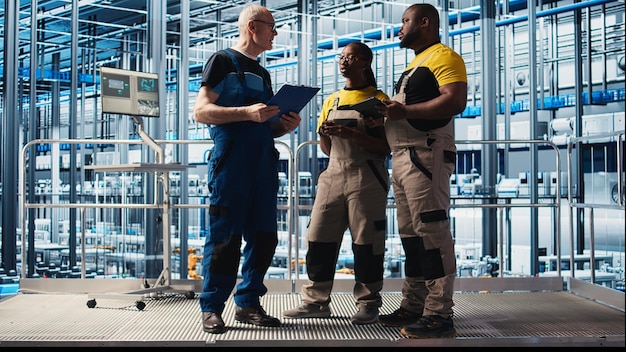How US Businesses Can Benefit from EPA’s Methane Emission Rules

US businesses can leverage the Environmental Protection Agency’s (EPA) new methane regulations by adopting innovative technologies, improving operational efficiency, and accessing financial incentives, ultimately reducing emissions and enhancing their market position.
The Environmental Protection Agency (EPA) has introduced new regulations targeting methane emissions, presenting both challenges and opportunities for businesses operating in the United States. Understanding and strategically responding to these rules can not only ensure compliance but also unlock significant benefits. This article explores how US businesses can leverage the new EPA regulations for methane emissions reduction, turning environmental responsibility into a competitive advantage.
Understanding the EPA’s New Methane Regulations
The EPA’s new methane regulations are designed to reduce methane emissions from various sectors, including oil and gas, agriculture, and landfills. These regulations aim to address methane, a potent greenhouse gas, and its impact on climate change. By understanding the specifics of these regulations, businesses can proactively prepare and identify opportunities for innovation and cost savings.
These regulations include a variety of components, such as leak detection and repair requirements, mandates for reducing emissions from new and existing sources, and incentives for adopting advanced technologies. Compliance with these rules is not merely a regulatory obligation but also a chance for businesses to showcase their commitment to sustainability and attract environmentally conscious investors and customers.
Key Components of the Methane Regulations
The EPA’s methane regulations encompass several key areas that directly affect US businesses. These components are designed to systematically reduce methane emissions across different sectors. Understanding each aspect is crucial for effective compliance and strategic planning.
- Leak Detection and Repair: Regular monitoring and immediate repair of methane leaks from equipment and infrastructure.
- Emission Reduction Mandates: Requirements for reducing emissions from both new and existing sources using best available control technologies.
- Advanced Technology Adoption: Incentives and guidelines for implementing innovative technologies that capture and utilize methane.
- Reporting and Transparency: Enhanced reporting requirements to ensure transparency and accountability in methane emissions data.
These components are interconnected and require a comprehensive approach to methane emissions management. Businesses that proactively address these areas can not only meet regulatory requirements but also achieve operational efficiencies and cost savings.
In conclusion, a thorough understanding of the EPA’s methane regulations is essential for US businesses aiming to comply with environmental standards and capitalize on the opportunities presented by sustainable practices. By focusing on leak detection, emission reduction, technology adoption, and transparent reporting, businesses can transform environmental challenges into strategic advantages.

Strategies for Compliance and Emissions Reduction
Complying with the EPA’s methane regulations requires a multi-faceted approach that integrates technological solutions, operational improvements, and strategic planning. Businesses can effectively reduce their methane emissions and ensure compliance by adopting comprehensive strategies tailored to their specific operations.
These strategies not only help in meeting regulatory requirements but also lead to significant cost savings, improved efficiency, and enhanced reputation. Embracing these approaches proactively positions businesses as leaders in environmental stewardship and innovation.
Implementing Advanced Technologies
Advanced technologies play a pivotal role in reducing methane emissions. Investing in and implementing these technologies can lead to significant reductions in emissions and long-term cost savings.
Here are several advanced technologies businesses can use:
- Methane Capture Systems: Capturing methane from sources like landfills and agricultural operations for use as renewable natural gas.
- Advanced Leak Detection Technologies: Using drones, infrared cameras, and sensors to detect and quickly repair methane leaks.
- Upgraded Equipment: Replacing outdated equipment with more efficient, low-emission alternatives.
These technologies not only reduce methane emissions but also offer opportunities for generating revenue through the sale of captured methane as renewable energy.
Operational Efficiency Improvements
Improving operational efficiency is another key strategy for reducing methane emissions. Simple changes in operating procedures can lead to substantial reductions in methane leakage and waste.
- Regular Maintenance: Implementing routine maintenance schedules to prevent equipment malfunctions and leaks.
- Enhanced Training: Providing comprehensive training to employees on best practices for minimizing methane emissions.
- Process Optimization: Streamlining operations to reduce venting and flaring of methane.
These improvements can often be implemented with minimal investment, yielding significant environmental and economic benefits. Businesses that prioritize operational efficiency demonstrate a commitment to sustainability and responsible resource management.
In summary, compliance with the EPA’s methane regulations requires a strategic combination of advanced technologies and operational efficiency improvements. By investing in methane capture systems, leak detection technologies, and upgraded equipment, and by focusing on regular maintenance, enhanced training, and process optimization, businesses can effectively reduce their methane emissions and achieve long-term sustainability goals.
Financial Incentives and Support Programs
To encourage methane emissions reduction, the US government offers various financial incentives and support programs. These programs provide businesses with the resources they need to invest in emissions reduction technologies and strategies.
Businesses can leverage these incentives to offset the costs of compliance and accelerate their transition to more sustainable operations. Understanding and utilizing these programs is a critical component of a successful methane emission reduction strategy.
Federal Grant Programs
Federal grant programs are a significant source of funding for methane reduction projects. These programs provide financial assistance to businesses, municipalities, and organizations undertaking projects that reduce methane emissions. Examples of federal grant programs include:
- EPA’s Methane Reduction Program: Offers grants for projects that develop and deploy innovative methane reduction technologies.
- USDA’s Rural Energy for America Program (REAP): Provides grants and loans for renewable energy projects, including methane capture and utilization systems.
These grant programs often require a competitive application process, but the financial rewards can be substantial, covering a significant portion of project costs.
Tax Credits and Deductions
Tax credits and deductions are another important form of financial incentive for methane reduction. These incentives reduce the tax burden on businesses that invest in qualifying methane reduction projects. Key tax incentives include:
- Renewable Energy Production Tax Credit (PTC): Provides a tax credit for electricity produced from renewable sources, including methane captured from landfills and agricultural operations.
- Investment Tax Credit (ITC): Offers a tax credit for investments in renewable energy equipment, such as methane capture and utilization systems.
Tax credits and deductions can significantly lower the cost of methane reduction projects, making them more financially attractive to businesses.

In conclusion, financial incentives and support programs play a crucial role in enabling US businesses to reduce methane emissions. By leveraging federal grant programs and tax credits and deductions, businesses can access the financial resources needed to invest in innovative technologies and sustainable practices. These incentives not only help in meeting regulatory requirements but also drive economic growth and environmental stewardship.
Case Studies of Successful Methane Reduction Initiatives
Examining real-world examples of successful methane reduction initiatives can provide valuable insights for US businesses. These case studies demonstrate how different organizations have effectively implemented strategies to reduce methane emissions, achieve compliance, and realize economic benefits.
By studying these examples, businesses can learn from the successes and challenges faced by others, and adapt proven strategies to their own unique circumstances. These case studies highlight the diverse approaches available and the potential for innovation in methane emissions management.
Dairy Farm Methane Capture
One notable case study involves a dairy farm that implemented a methane capture system to convert manure into biogas. The farm installed an anaerobic digester, which breaks down organic matter in the absence of oxygen, producing methane-rich biogas. The biogas is then used to generate electricity, which is fed back into the grid.
This initiative not only reduced methane emissions but also created a new revenue stream for the farm. The system also improved waste management by reducing the volume of manure and mitigating odors. The project was supported by federal grants and tax credits, making it financially viable for the farm.
Landfill Gas-to-Energy Project
Another successful case study involves a landfill that implemented a gas-to-energy project. The landfill captures methane gas produced by decomposing waste and uses it to fuel a power plant. The electricity generated is sold to the local utility company.
This project significantly reduced methane emissions from the landfill, helping the municipality comply with environmental regulations. The project also generated a substantial revenue stream, offsetting the costs of landfill operation and maintenance. The project was financed through a combination of private investment and government incentives.
In conclusion, case studies of successful methane reduction initiatives offer valuable lessons and inspiration for US businesses. By examining examples such as dairy farm methane capture and landfill gas-to-energy projects, businesses can gain insights into the diverse strategies and technologies available for reducing methane emissions. These case studies demonstrate the potential for achieving both environmental and economic benefits through proactive methane emissions management.
The Role of Policy and Advocacy
Policy and advocacy play a crucial role in shaping the landscape of methane emissions reduction. Businesses can actively engage in policy discussions and advocate for regulations and incentives that support their efforts to reduce methane emissions.
Participating in policy and advocacy not only helps create a favorable regulatory environment but also showcases a company’s commitment to sustainability and responsible environmental practices. This involvement can enhance a company’s reputation and attract environmentally conscious investors and customers.
Engaging with Policymakers
Engaging with policymakers is a key aspect of advocacy. Businesses can build relationships with elected officials and regulatory agencies to share their expertise and perspectives on methane emissions reduction. Opportunities for engagement include:
- Meetings with Legislators: Discussing the challenges and opportunities related to methane emissions reduction with elected officials.
- Testifying at Hearings: Providing expert testimony at legislative hearings on environmental policy.
- Submitting Comments on Proposed Regulations: Offering feedback on proposed regulations to ensure they are practical and effective.
By actively engaging with policymakers, businesses can help shape environmental policies that promote innovation and sustainability.
Supporting Industry Associations
Supporting industry associations is another effective way to advocate for policies that support methane emissions reduction. Industry associations often represent the collective interests of their members and can advocate for policies that benefit the entire sector.
- Joining Trade Groups: Participating in industry associations focused on environmental stewardship and emissions reduction.
- Contributing to Advocacy Efforts: Supporting the association’s advocacy efforts through financial contributions and participation in lobbying activities.
By working together through industry associations, businesses can amplify their voices and ensure their perspectives are heard by policymakers.
In summary, policy and advocacy are essential components of a comprehensive methane emissions reduction strategy. By engaging with policymakers and supporting industry associations, businesses can help shape a regulatory environment that promotes innovation, sustainability, and responsible environmental practices. This proactive involvement not only benefits the environment but also enhances a company’s reputation and fosters long-term economic growth.
Future Trends in Methane Emissions Management
The field of methane emissions management is constantly evolving, with new technologies and strategies emerging to address the challenge of climate change. Understanding future trends in this area can help US businesses stay ahead of the curve and capitalize on emerging opportunities.
By anticipating future developments, businesses can make informed investment decisions and develop long-term strategies for methane emissions reduction. This proactive approach not only ensures compliance but also positions businesses as leaders in environmental stewardship and innovation.
Advanced Monitoring Technologies
Advanced monitoring technologies are expected to play an increasingly important role in methane emissions management. These technologies provide real-time data on methane emissions, allowing businesses to quickly identify and address leaks and other sources of emissions. Examples of advanced monitoring technologies include:
- Satellite Monitoring: Using satellites to detect and measure methane emissions over large areas.
- Drone-Based Monitoring: Deploying drones equipped with methane sensors to conduct detailed inspections of facilities and infrastructure.
- IoT Sensors: Installing internet-of-things (IoT) sensors to monitor methane emissions at specific points in a facility.
These technologies enable more precise and efficient monitoring, leading to faster detection and reduction of methane emissions.
Artificial Intelligence and Data Analytics
Artificial intelligence (AI) and data analytics are also expected to transform methane emissions management. AI algorithms can analyze large datasets to identify patterns and predict potential leaks, allowing businesses to proactively address emissions risks. Data analytics can also be used to optimize methane capture and utilization processes.
In conclusion, the future of methane emissions management is characterized by advanced monitoring technologies and the integration of artificial intelligence and data analytics. By embracing these trends, US businesses can enhance their ability to detect, reduce, and utilize methane emissions, contributing to a more sustainable and resilient future.
| Key Point | Brief Description |
|---|---|
| 🌱 EPA Regulations | New rules targeting methane emissions from various sectors. |
| 💰 Financial Incentives | Grants and tax credits available for reducing methane emissions. |
| 🔬 Advanced Technologies | Use of drones, AI, and IoT for monitoring and leak detection. |
| 🤝 Policy Engagement | Advocating for supportive regulations and industry collaboration. |
FAQ
▼
The main goals include reducing methane emissions from oil & gas, agriculture, and landfills to mitigate climate change impacts and promote sustainable practices.
▼
Financial incentives include federal grant programs like EPA’s Methane Reduction Program and tax credits like the Renewable Energy Production Tax Credit (PTC).
▼
Businesses can improve efficiency through regular maintenance, enhanced employee training, and process optimization to minimize methane leakage and venting.
▼
Advanced technologies include methane capture systems, drones with infrared cameras, and IoT sensors for real-time monitoring and leak detection.
▼
Businesses can engage by meeting with legislators, participating in industry associations, and submitting comments on proposed regulations to shape environmental policies.
Conclusion
In conclusion, US businesses have significant opportunities to leverage the new EPA regulations for methane emissions reduction. By understanding the regulations, implementing advanced technologies, utilizing financial incentives, and engaging in policy advocacy, businesses can not only comply with environmental standards but also enhance their market position and contribute to a more sustainable future.




